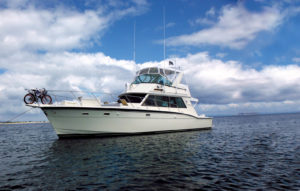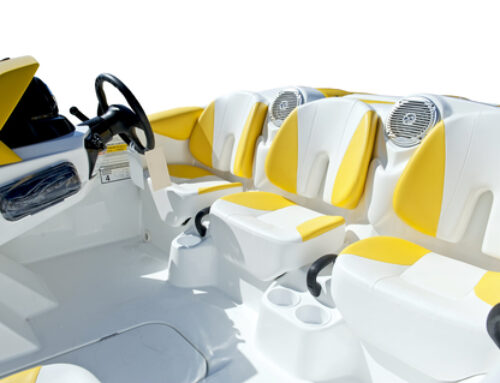Contingency plan: An unexpected breakup leads to solo success

Managing the elements: To keep out rain and spray from the ocean while keeping the interior of the vessel comfortable is a common request made of marine fabricators like Cindy Boersema – but every vessel is different, requiring a different approach to the design. Owners of The Midwestern vessel requested an upper bridge enclosure that eliminates all possible areas water could enter, but that still has a window for ventilation. Boersema and her team designed and installed a window that completely zips out, with a fabric “hinge” at the bottom of the curtain to prevent leakage. The most unique part of the enclosure design was the upper bridge side curtains: They used two No.10 coil separating zippers for each removable center section of the side curtains, which start at the top and end at the bottom, incorporating a flap over each of the zippers. “I’m very picky,” Boersema says. “There’s always a way to make something that works better for the client- just give us the opportunity and we’ll figure it out.”
“I think the most significant lesson I’ve learned over the past couple of years is not to get too comfortable,” says Cindy Boersema, owner of The Nautical Needle in Holland, Mich. “Being a business owner is not about relying on others to always be there to work for you and with you—because they can be gone in a moment, and you need to have a plan for that.”
Boersema learned to sew in high school home economics and later did production sewing in the automotive industry, which eventually led to sewing marine canvas. She implemented improved canvas production processes, first at one company and then another where she worked for several years. In 2005, Boersema and two co-workers opened their own shop crafting custom options for boats and yachts. After six months one of the partners dropped out, and Boersema and the remaining partner dissolved the original company and restarted as The Nautical Needle.
The company did well, finding and training solid employees and establishing a substantial client base. “I put a lot of effort into training staff to get them to perform to my standards,” Boersema says. “I have a sense of pride knowing
I teach the future generation a skill and am leaving a legacy.”
Partnership priorities
In 2010, Boersema’s remaining partner decided to leave the business—and she was faced with the decision of whether to buy him out or close the company. “I was shocked,” she says. “I was forced to make a swift decision, but once I did I felt a sense of liberation, despite some sleepless nights.”
Now that the dust has settled and Boersema has done the hard work of transitioning to sole ownership, finding someone to take on the duties of her former partner and dealing with replacing staff that followed the former partner to his new business, she’s ready to share some of what she learned from the experience.
She offers three pieces of advice for anyone entering a partnership: make sure to have an exit plan, include a non-compete agreement, and create a back-up plan.
“I’ve known several people who have been in lifetime partnerships—partnerships that are still going and work well,” Boersema says. “Still, when you enter into any partnership, you should have a plan today for its end.” Fortunately, Boersema and her partner included an “option to buy” in the operator’s agreement, so Boersema was able to secure financing and buy out her partner. “If we had not included the option to buy in the agreement I can predict that The Nautical Needle would not be here—we would have dissolved,” she says.
Boersema also advises having a non-compete clause in the agreement, pointing out that typically at the start of a partnership both parties are so focused on opening the business that potential problems are ignored. “Having the non-compete not only protects you, having the discussion also tells you something about your partner,” Boersema says. “If he or she won’t agree to one—that should put up a red flag for you.”
The decision to buy out her partner did not take Boersema long, but re-staffing and stabilizing the business presented significant challenges, which would have been eased a bit by having a back-up plan. “Think about what you’d do tomorrow if you no longer had a partner. Who will fill their duties?” she says. “It can happen quickly, and if you have a plan you can recover that much quicker.”
Talent search
Replacing staff that ended up leaving shortly after Boersema became sole owner was a priority—and a challenge. One of the shop’s fabricators remained with the company, and he was vital to keeping the business going as new staff was hired. “I placed a lot of confidence in him, and now have highly capable and talented people here,” she says. “But we’ve gone through a lot of employees to get to this point.”
To save time, Boersema used staffing agencies to screen potential employees. “If we put an ad in the paper or on Craigslist then we’re getting all the calls,” she says. “If we let the staffing agency find us someone, a lot of the initial work is already done, and we can do a 15-minute interview and say yea or nay.”
Power of prototypes
Clients’ support also continues to factor into Boersema’s company’s success—above and beyond placing orders for custom goods. Boersema and her staff develop prototypes as a part of their work, based sometimes on clients’ requests and sometimes on her own concepts. Typically, a business or individual presents a need, and Boersema will educate them on the best fabrics to use, the design process and the most efficient way to produce the item. If the item will be reproduced by the client, Boersema signs a non-disclosure agreement.
Of course there’s no guarantee that items will be successful in the marketplace, so based on Boersema’s assessment she either charges a lump sum at the project’s completion or takes a royalty off products sold. “Let’s face it—inventors don’t always come up with something that’s going to hit the market strong,” she says. “But when it works it’s really great to see customers making a living on products we helped them design.”
At times, individual clients present an idea that they only need for personal use, and after Boersema and her team prototype and produce it, the client gives them the rights to the design. “They’ll tell me to make one for them, which they’ll pay for, and after that I should keep the pattern and use it for the company,” Boersema says. “It’s touching when clients care about our future and want us to succeed.”
The Nautical Needle is thriving because the bottom line for Boersema is perseverance, integrity and producing quality products. “We’re still here,” she says. “We haven’t given up—and look forward to what the next year will bring.”
Sigrid Tornquist is a freelance writer and editor from St. Paul, Minn.
Q&A with Cindy Boersema of The Nautical Needle
What is one way you create and maintain employee satisfaction?
It’s very important to me that our employees feel secure, and a huge part of that is providing health insurance for them. We have an alternative supplement plan in place right now, but are looking into a plan that’s a new part of IFAI’s member benefits.*
What have you changed regarding how you run the business in the last couple of years?
Sales and quoting is the area that has changed
the most since I purchased The Nautical Needle.
I recognized that sales is not my strong point and I need to stay out of it. Instead I’ve focused on finding the right person for the position, and giving them the tools they need to excel—and it’s working out great.
* IFAI has partnered with Digital Insurance, a company that specializes in providing group insurance and member benefits in the U.S. For more information, visit www.ifai.com/insurancebenefits.
 TEXTILES.ORG
TEXTILES.ORG 





